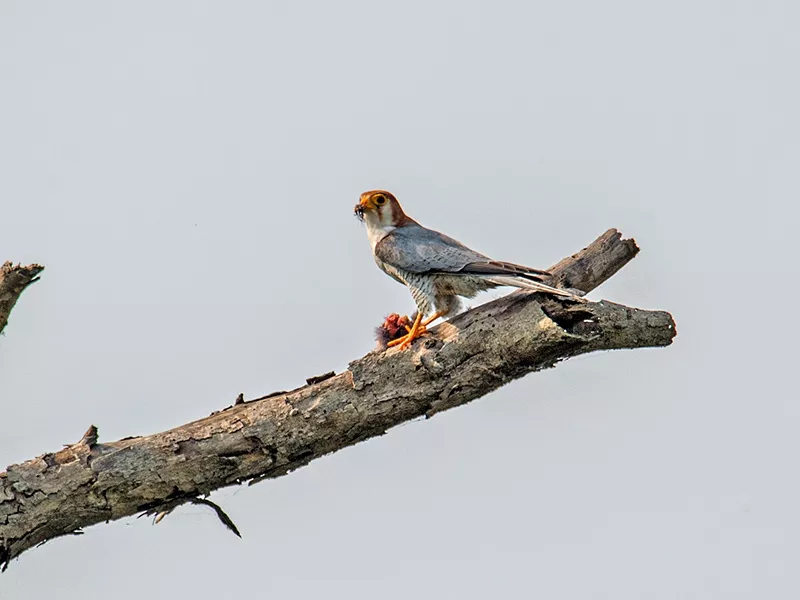The red-necked falcon (Falco chicquera) is a bird of prey in the Falconidae family. This medium-sized falcon has a blue-gray upper body and wings, a maroon crest, the main feathers on the wings are black, and the tip of the tail A black belt is unique. Mostly hunt in pairs at dawn and dusk, hunting small birds, bats and squirrels. Mainly distributed in the open plains of the Indian subcontinent to farther west in southeastern Iran.
What does Red-necked falcon look like
The Red-necked falcon has a body length of 36 cm, a wingspan of 55-70 cm, and a weight of 139-305 grams. This slender-bodied little falcon has short, pointed wings. Both sexes have the same plumage. However, females were 9% to 24% larger in size and 50% larger in body weight. Young birds differ from their parents in that they only acquire definitive plumage during the second part of their first year.
In adults the entire hood, nape, nape and sides of the neck are reddish brown with very fine black stripes. The area from the forehead to the eyes is white. The cheeks form a white circular patch with black malar bands. The upper body is gray or grayish blue. Usually covered with fine black streaks and indistinct streaks. The black primary flight feathers contrast with the rest of the upper part. The tail is similar to the back, ie solid gray or with black stripes, ending in a rectangular shape with a broad black band and a thin white tip. The underparts are mostly white, but the chest can be slightly black-striped, more or less reddish-brown. The abdomen is streaked to varying degrees and appears gray from a distance.
Juveniles have plumage patterns similar to adults, but the plumage is duller, browner, and darker. The hood is tan or chestnut brown with distinct stripes. The contour of the cheeks is more pronounced. The back and wing coverts are dark gray with reddish-brown edges, giving a temporary reddish-brown appearance in fresh plumage. The tail is very similar to the parent’s tail. The throat is white, but the rest of the underside is more or less pale yellow or reddish brown. The thighs and flanks are usually free of stripes.
Iris brown to dark brown. Legs with yellow cere in adults.
Red-necked falcon habitat
The Red-necked falcon lives between sea level and 1000 meters above sea level. They prefer to occupy acacia trees and are also frequent on trees in plantations, as well as those found in grasslands, cultivated fields, or near villages. They also occur in arid habitats of plains and hills and semi-deserts with palm trees and shrubs.
Red-necked falcon living habit
- Behavior
The Red-necked falcon that lives in India is not timid. Sometimes they perch on tree stumps, posts or mounds, usually they perch in tree canopies. Red-necked falcons walk on the ground very frequently. Adult birds usually live in pairs. The air show is very discreet. At the start of the breeding season, they are restricted to short flights accompanied by mutual calling. Red-necked falcons are mostly resident birds, which doesn’t prevent them from making brief excursions when rainfall, drought, or food resources are scarce or plentiful.
Red-necked falcons sometimes hunt after dark. Most of their prey is caught after aerial chases, sometimes in ambush hunting from well-camouflaged perches or on posts or mounds near watering holes in well-covered areas. When hunting, these predators usually fly very low to the ground, but they are perfectly capable of gaining altitude to stand above their prey if necessary. Pairs sometimes hunt cooperatively and share their prey. They are capable of chasing through leaves and bushes. Males often team up with red-faced song hawks. The connections between them are often productive.
- Sound
The Red-necked falcon is usually silent except when nesting. In India, the call has been described as strange, harsh and mournful, and the “tiriririririririri” call heard in the Indian subcontinent is the whining sound of young Red-necked falcons driven from their nest by their parents.
What does Red-necked falcon eat
The Red-necked falcon feeds almost entirely on birds, accounting for up to 98%. Adult bald eagles occasionally catch small rodents, lizards and insects. The birds are mainly passerines weighing up to 75 grams, such as larks, partridges, weavers, and partridges. However, larger prey of up to 150 grams can sometimes be caught: swallows, quail, pigeons, cuckoos, kingfishers, bee-eaters, and even some wading birds. In the category of insects, there are large beetles, locust swarms, and winged termites.
Distribution area of Red-necked falcon
- Resident birds: Bangladesh, Nepal and Pakistan.
- Breeding place: India.
- Wandering: Myanmar and Sri Lanka.
Mode of reproduction
Red-necked falcons mainly start breeding at the end of the dry season. Eggs are laid and hatched when vegetation is very poor and passerines are abundant. In Pakistan, it is from February to June, and in India, it is from January to June. Eggs are usually laid in old or completely refurbished crow nests, sometimes in abandoned raptor nests. Eggs are sometimes simply laid on debris of leaves that accumulate at the top of the palm tree. Nests are usually placed in palm trees, acacia trees or other thorny trees, at a height of 4-30 meters from the ground. Each clutch lays 3-4 eggs, and the incubation time is 32-35 days. The young birds leave the nest for 34-40 days.


 Facebook
Facebook  Instagram
Instagram  Youtube
Youtube 